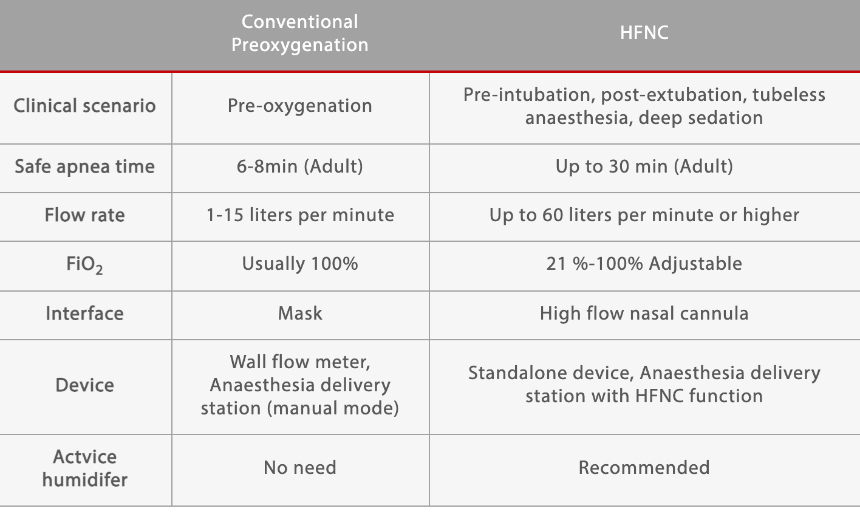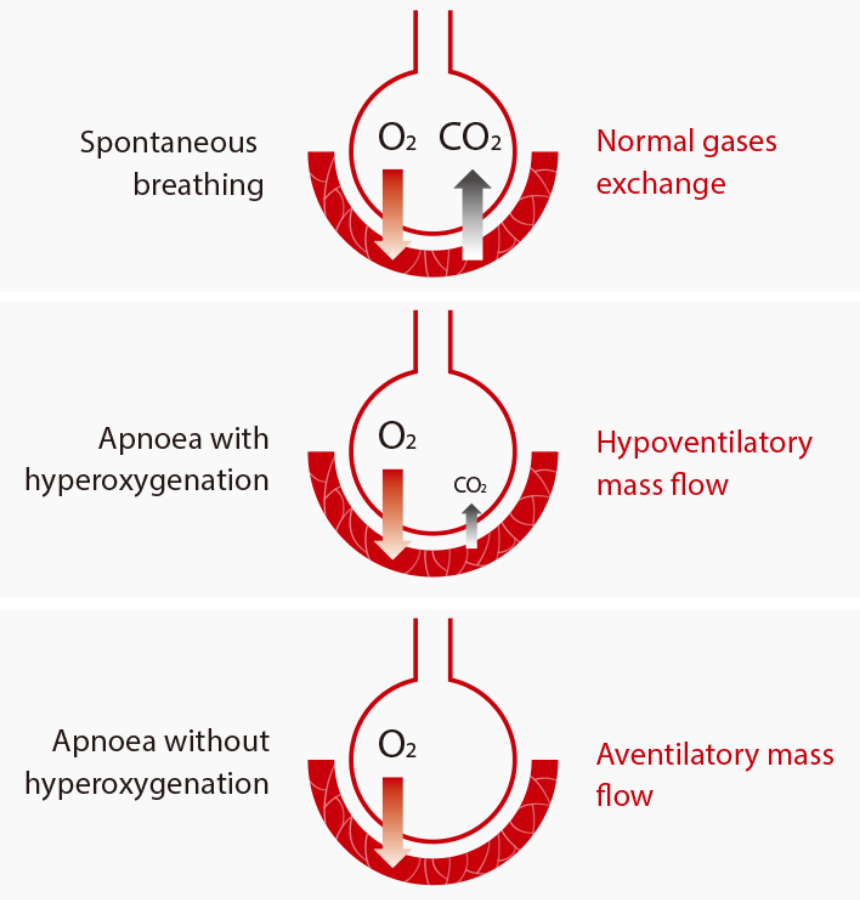Avoiding Hypoxemia during Anaesthesia
During surgery, there is a potential risk of being exposed to a prolonged apnoea followed by an arterial haemoglobin desaturation. Preoxygenation using 100% oxygen before the anaesthesia induction is highly recommended to delay the onset of arterial haemoglobin desaturation during prolonged apnoea[1].
Obese, neonatal, paediatric, pregnant, septic, and critically ill patients are at a higher risk of showing a reduced oxygen reserve.

Source: Incidence and prediction of inadequate preosygenation before induction of anaesthesia. 2014. 33(4): p. e55-8.[2]
Conventional Preoxygenation versus High Flow Nasal Cannula (HFNC) oxygen
Conventional preoxygenation aims to achieve a preoxygenation status before an anesthetic procedure and to support planned extubation. It has conventionally been delivered using nasal cannula or masks, therefore the maximal oxygen flow rates that these devices can deliver are limited to up to 15 liters per minute, which is far lower than the failure or difficult intubation. Ambient air dilutes the supplied oxygen, causing a significant reduction of the FiO2 in the alveoli. Furthermore, oxygen delivered by conventional preoxygenation hardly meets the requirements of heating and humidification in these patients[3].
High flow nasal cannula (HFNC) oxygen is an oxygen supply system capable of delivering up to 100% humidified and heated oxygen at a flow rate of 60 liters per minute and eventually higher[3].

Apnoeic oxygenation
When apnoea occurs, the oxygen extraction from the alveoli to the arterial blood flow develops into a decrease of interalveolar pressure that becomes subatmospheric. This situation generates a pressure gradient that allows more oxygen to passively move into the alveolar space[4,5], known as “aventilatory mass flow”[6]. Apnoeic oxygenation is achieved by administering HFNC oxygen and removing the nitrogen that otherwise would be accumulated in the lung and, combined with the carbon dioxide accumulation, diminishes the available pressure gradient for oxygen transfer to the alveolus and hastens the onset of hypoxaemia[7].

Apnoeic oxygenation may prolong safe apnoea time and increase first-pass success during emergency intubation[8].
Which are the HFNC oxygen applications to increase patient safety in anaesthesia?

Read more
Striving for best practise towards patient safety in anaesthesia settings, Mindray incorporates high flow nasal cannula (HFNC) oxygen to the A8/A9 anaesthesia workstations, which contributes to safer patient management by addressing potential complications related to hypoxaemia during anaesthetic procedure and difficult airway management.
References:
[1] Benumof, J.L., Preoxygenation: best method for both efficacy and efficiency. Anesthesiology, 1999. 91(3): p. 603-5.
[2] Baillard, C., et al., Incidence and prediction of inadequate preoxygenation before induction of anaesthesia. Ann Fr Anesth Reanim, 2014. 33(4): p. e55-8.
[3] Weingart, S.D. and R.M. Levitan, Preoxygenation and prevention of desaturation during emergency airway management. Ann Emerg Med, 2012. 59(3): p. 165-75 e1.
[4] Lyons, C. and M. Callaghan, Uses and mechanisms of apnoeic oxygenation: a narrative review. Anaesthesia, 2019. 74(4): p. 497-507.
[5] Zhu, Y., et al., High-flow nasal cannula oxygen therapy versus conventional oxygen therapy in patients after planned extubation: a systematic review and meta-analysis. Crit Care, 2019. 23(1): p. 180.
[6] Sleath, G.W., L.C. Jenkins, and H.B. Graves, Diffusion in anaesthesia. Can Anaesth Soc J, 1963. 10: p. 72-82.
[7] Bartlett, R.G., Jr., H.F. Brubach, and H. Specht, Demonstration of aventilatory mass flow during ventilation and apnea in man. J Appl Physiol, 1959. 14(1): p. 97-101.
[8] Kolettas, A., et al., Influence of apnoeic oxygenation in respiratory and circulatory system under general anaesthesia. J Thorac Dis, 2014. 6 Suppl 1: p. S116-45.
